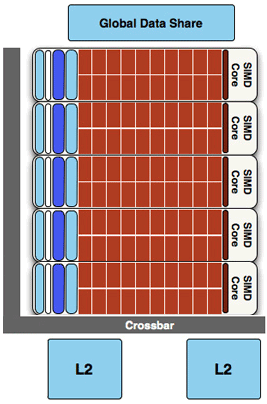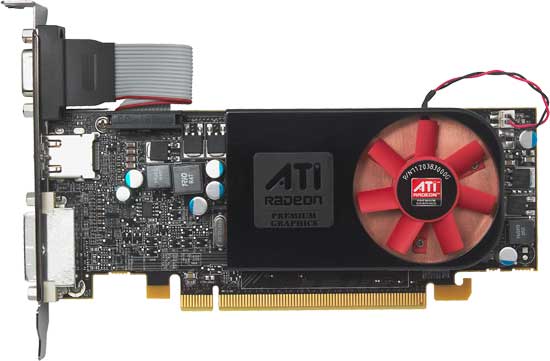AMD’s Radeon HD 5570: Low Profile, Higher Performance
by Ryan Smith on February 9, 2010 12:00 AM EST- Posted in
- GPUs
When AMD launched the 5670, they told us they had 2 more cards on the way: the 5450, and a 5500 series card. Last week we saw the launch of the 5450, utilizing the Cedar GPU and finishing off AMD’s chip stack. Today we’re looking at that 5500 series card, the Radeon HD 5570.
| AMD Radeon HD 5670 | AMD Radeon HD 5570 | AMD Radeon HD 4670 | AMD Radeon HD 5450 | AMD Radeon HD 4550 | |
| Stream Processors | 400 | 400 | 320 | 80 | 80 |
| Texture Units | 20 | 20 | 32 | 8 | 8 |
| ROPs | 8 | 8 | 8 | 4 | 4 |
| Core Clock | 775MHz | 650 | 750MHz | 650MHz | 650MHz |
| Memory Clock | 1000MHz (4000MHz data rate) GDDR5 | 900MHz (1800MHz data rate) DDR3 | 1000MHz (2000MHz data rate) GDDR3 | 800MHz (1600MHz data rate) DDR3 | 800MHz (1600MHz data rate) DDR3 |
| Memory Bus Width | 128-bit | 128-bit | 128-bit | 64-bit | 64-bit |
| Frame Buffer | 1GB / 512MB | 1GB | 1GB / 512MB | 1GB / 512MB | 1GB / 512MB |
| Transistor Count | 627M | 627M | 514M | 292M | 242M |
| TDP | 61W | 42.7W | 59W | 19.1W | 25W |
| Manufacturing Process | TSMC 40nm | TSMC 40nm | TSMC 55nm | TSMC 40nm | TSMC 55nm |
| Price Point | $99 / $119 | $80-$85 | $60-$90 | $49-$59 | $35-$55 |
Right off the bat, the 5570 marks a bit of a departure from AMD’s numbering scheme for the 4000 series. While the Radeon HD 4550 was the faster of the two cards utilizing AMD’s cheapest GPU (RV710), the 5570 is not a faster Cedar card. Instead it’s a slower Redwood card, putting it in the ballpark of the 5670’s rather than the 5450’s.

AMD has done 3 things to differentiate the 5570 from the 5670. The first of which is to significantly castrate the 5670’s memory bandwidth. While the 5670 had 1GHz (4GHz effective) GDD5, the 5570 drops that for simple 900MHz (1.8GHz effective) DDR3, giving the card only 45% of the memory bandwidth of the 5670. The second change is more customary, and that is lowering the core clock from 775MHz to 650MHz, leaving the card with roughly 83% of the computational/rendering/texturing performance of the 5670. None of the SIMDs have been disabled however, so this is a fully functional Redwood GPU.

Finally, in another significant departure from the 4000 series, this is AMD’s second official low-profile video card. For the 4000 series AMD’s only official low-profile card was the 4350, although vendors were known to do low-profile versions of the 4550 (RV710) and the 4650 (RV730). Here AMD is not leaving that up to their vendors, and is doing an official retail low-profile design for their more powerful Redwood GPU. This allows AMD to fill a potential hole in their lineup by offering a low-profile GPU with better than bargain-bin performance.
This card also fills the overall price/performance hole in AMD’s 5000 series lineup, giving them something between the $9 9 5670 and the $50-$60 5450. AMD’s MSRP on this card will be $85, a bit more than half way between the other two cards. Unlike the 5670 and 5450, we’ll only be seeing a single official configuration of the 5570: 1GB of 900MHz DDR3. Our sample comes with 900MHz Samsung chips. It’s also worth noting that this is the same memory configuration as the base Radeon HD 4670, which also used 1GB of 900MHz DDR3.
Between the drop in the core clock and the movement to DDR3, AMD has lopped off nearly 30W from the 5670’s load power usage, bringing the 5570 in at 42.7W. Idle power also drops by nearly 33%, for 9.7W. This low power usage is a big part of why AMD can get away with the 5570 being a low-profile card, as they only need a small single-slot blower to cool the card. The reference cooler (not that we expect many – if any – vendors to use it) is a blower design built upon a copper heatsink, with a small fan blowing air towards the front of the card.

The port configuration is the same as the 5450: 1 VGA, 1 DVI, and 1 smaller digital port. Our sample came with a HDMI port, with vendors free to use an HDMI port or a DisplayPort depending on whether they want Eyefinity support as enabled by using a DisplayPort. As has been the case with all of AMD’s sub-$100 5000 series cards, Eyefinity is still cost-prohibitive at this time due to a lack of cheap active DisplayPort adaptors and monitors offering DisplayPort inputs.
AMD considers NVIDIA’s GT 220 the chief competition for this card. The GT 220 isn’t an official low-profile card, but there are a few models out there in that form factor. In terms of overall pricing, a number of GDDR5 GT 240s can be found at or right below $85, making the GT 240 the closest competitor for this card.










36 Comments
View All Comments
vlado08 - Tuesday, February 9, 2010 - link
Please give us comparison with intel HD graphics and also Ion in video post processing. Can we change gamma in intel drivers? Can we select different interlacing? Can we select the output RGB or YUV, 0-255 or 16-235? In some articles here on Anandtech you point intel HD as an perfect HTPC graphics? But is it really?Moizy - Tuesday, February 9, 2010 - link
I forgot that you included those screen shots of the 210 and the 220 doing the "cheese slices" test in the 5450 article. Thanks for pointing that out. I downloaded those screen-shots as well. Very useful for comparison.It's kind of irritating that they (AMD and nVidia) can't get the HTPC thing fully right unless you spend $100 and get a card that has a bunch of 3D capabilities that aren't needed if you just want to enjoy HD. I wonder, though, if half of the 5570's video-quality issues are driver-related and not hardware-related. As far as I know, the 4670 can handle all of the video-quality stuff, and 5570 seems very comparable hardware-wise.
mariush - Wednesday, February 10, 2010 - link
We wouldnt need these 100$ cards just to run a movie well if the crap that INTERLACING is would have been removed from the HD standard.Almost all the performace problems are caused by the need to deinterlace content. With progressive content, these cards don't have issues.
Slaimus - Tuesday, February 9, 2010 - link
The card really should be clocked at ~500Mhz with lower voltage, and maybe even 80 disabled SPs. All of that power wasting rendering ability is mostly idling while waiting for memory.MrSpadge - Tuesday, February 9, 2010 - link
Agreed. Although that could become a HD5550.wolrah - Tuesday, February 9, 2010 - link
Why do we still have VGA ports on these things? Those still using old-ass monitors can use an adapter off the DVI-I port that pretty much every video card includes for free. Give me DVI-I Dual Link, HDMI, and DisplayPort. VGA is dead and can be adapted with no downsides from other ports, there is no reason to keep putting that useless port there.Taft12 - Tuesday, February 9, 2010 - link
Spoken like someone who doesn't understand how every penny needs to be scrimped with the miniscule margins on these parts, especially given DVI royalties.MadMan007 - Tuesday, February 9, 2010 - link
You couldn't take a metal tool to the Sapphire heatsink to find out what material it is? I doubt it's actual 'paint' it's probably anodizing on aluminum which should be easy to scrape through.Ryan Smith - Tuesday, February 9, 2010 - link
I actually tried scraping through it, but I don't exactly have the right tool for the task. At any rate, Sapphire tells me it's Aluminum.shiggz - Tuesday, February 9, 2010 - link
Any idea if this card can handle MPCHC "sharpen complex 2" without stuttering on 720p files?